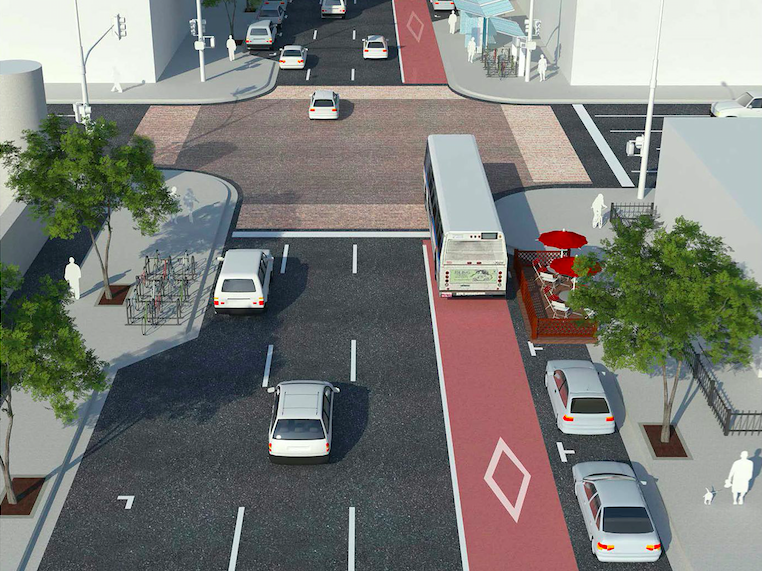
Rendering of a proposed bus lane on the Broadway/Lincoln corridor
As Denver’s population continues to boom, city leaders are stepping up to provide the direction and resources necessary to make public transit a viable option for city residents and stem the growing tide of drive alone commuting.
In 2004, the Regional Transportation District (RTD) began a massive regional bus and rail network expansion called FasTracks. While impressive on paper, the costly network primarily serves suburban commuters and is far less useful for trips beginning and ending within Denver. RTD has paid less attention to bus frequency and reliability within the city itself, including how local buses interact with the regional lines. Redundant bus routes and too many stops, and the lack of dedicated transit lanes, results in frustratingly slow service that’s more competitive with walking than driving. It’s no wonder a recent downtown commuter survey shows that workers with shorter commutes take transit less frequently than workers who live further out.
The City of Denver, led by Denver Public Works’ Crissy Fanganello, has recently embraced a hands-on approach to transit, realizing the city needs to take a more active role in planning, implementing, and even operating transit to meet city priorities. With the Denver region’s first non-RTD transit plan, Denver Moves: Transit, kicking off last year, the city is examining where the current system is failing to provide residents with fast, frequent, and walkable connections to jobs and neighborhoods, and how the city should step in to remedy these problems. With the 2017 General Obligation Bond up for a vote this fall, Mayor Michael Hancock has signalled his willingness to devote $370 million to creating transit-friendly streetscapes. Bringing more resources to expanded city transit will likely require additional funding measures after 2017.
The Denver Moves transit plan recently completed a citywide transit needs study. The findings weren’t surprising: pedestrian access to transit stations is lacking, bus frequency falls off a cliff outside of peak hours, many routes are indirect and illegible, and merely a quarter of bus stops feature basic shelters. Based on community input, the plan established broad goals to guide future transit investments. Increased frequency, better rider information, strengthened neighborhood connections, smarter land use development, and “multimodal solutions to first/last mile issues” all made the cut. The next step is to identify corridors where transit service needs improvement and concrete steps to achieve it.
The city ought to commit itself to an ambitious target for providing residents with access to high-quality transit. With only 36 percent of Denver residents within walking distance of frequent all-day service, expanding and reorganizing routes and frequency should be a top priority. For example, Seattle’s ten-year transportation plan sets a goal of providing 72 percent of residents with frequent all-day transit service within a ten-minute walk of their homes. Since walking remains a challenge in much of Denver, some kind of safe routes to transit street retrofit program will also likely be important to improving access transit.

Walking still presents a challenge in many Denver neighborhoods
Denver could streamline implementation to quickly turn ambitious goals into on-the-ground action. Nashville provides inspiration: Mayor Megan Barry just directed her staff to create a unit composed of key transportation and transit staff to streamline decision-making and increase the pace of project delivery. Denver Public Works is already experimenting with innovative street design projects that prioritize travel by foot, bus, and bike. The department installed a temporary, two-way bike lane on busy South Broadway with plans to lengthen it, and will soon expand two dedicated bus-lanes along the same Broadway-Lincoln corridor. Making these early forays into quick-build street improvements into regular programs with extensive pipelines of pending improvements would dovetail well with city ambitions to bring better transit neighborhoods and commercial districts.
 On the Brink: Will WMATA’s Progress Be Erased by 2024?
On the Brink: Will WMATA’s Progress Be Erased by 2024?
The experience of being a WMATA rider has substantially improved over the last 18 months, thanks to changes the agency has made like adding off-peak service and simplifying fares. Things are about to get even better with the launch of all-door boarding later this fall, overnight bus service on some lines starting in December, and an ambitious plan to redesign the Metrobus network. But all of this could go away by July 1, 2024.
Read More A Bus Agenda for New York City Mayor Eric Adams
A Bus Agenda for New York City Mayor Eric Adams
To create the “state-of-the-art bus transit system” of his campaign platform, Mayor Adams will have to both expand the quantity and improve the quality of bus lanes. We recommend these strategies to get it done.
Read More